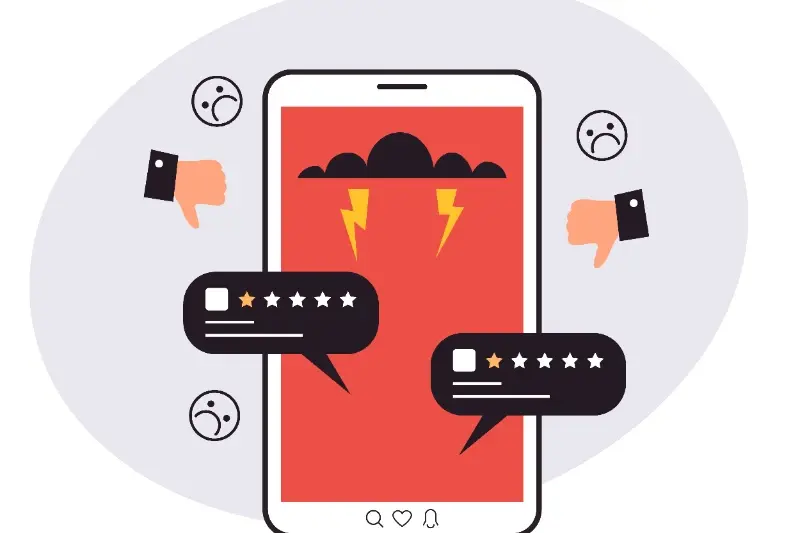Star Rating Psychology: What Users Really Think
You've just launched your app after months of development, sleepless nights, and countless iterations. You're convinced it's brilliant—your team loves it, your friends think it's clever, and you're ready to watch those downloads roll in. Then reality hits. Your app sits at 2.8 stars with reviews that feel like personal attacks. Meanwhile, a competitor with what you know is an inferior product somehow maintains 4.6 stars and thousands of glowing reviews. How does that even happen?
After eight years of building mobile apps, I can tell you that star ratings are one of the most misunderstood aspects of app success. Most developers think ratings are just a simple reflection of quality—good app gets good ratings, bad app gets bad ratings. But the truth is far more complicated. User psychology plays tricks on us all; what people say they want in an app and what actually makes them leave a five-star review are often completely different things.
The difference between a 3-star app and a 4-star app isn't always about functionality—it's about understanding how users think and feel when they interact with your product
Star ratings influence everything from app store rankings to user trust, but they don't always tell the story you think they do. Some apps benefit from negative reviews, others suffer despite being technically superior, and the whole system is riddled with psychological quirks that can make or break your success. Understanding these patterns isn't just useful—it's essential if you want your app to survive in today's crowded marketplace.
The Numbers Game
When people look at app ratings, they don't just see numbers—they see trust signals that guide their decisions faster than you might think. Most users glance at that star rating within seconds of finding your app, and their brain has already started forming opinions before they've even read a single review.
The psychology behind this is quite straightforward. Our brains are wired to make quick decisions using patterns and shortcuts, and star ratings provide exactly that. A 4.2-star rating feels significantly different from a 3.8, even though we're talking about less than half a star's difference.
What Each Rating Range Really Means to Users
Different star ratings trigger different emotional responses, and understanding these can help explain user behaviour patterns:
- 5 stars: "This must be perfect" (but also raises suspicion about fake reviews)
- 4.5-4.9 stars: "This looks really good and trustworthy"
- 4.0-4.4 stars: "Decent quality, probably worth downloading"
- 3.5-3.9 stars: "Might be okay, but I'll check competitors first"
- Below 3.5 stars: "Something's definitely wrong here"
What's interesting is how users process these numbers differently across age groups and tech experience levels. Younger users tend to be more sceptical of perfect ratings, whilst older users often gravitate towards higher numbers without questioning their authenticity.
The volume of ratings matters too—an app with 10,000 ratings at 4.2 stars feels more reliable than one with 50 ratings at 4.8 stars. Users instinctively understand that more data points mean more reliable averages, even if they can't articulate why they feel that way.
Why Stars Matter More Than Words
Here's something I've learnt after years of working with app clients—people don't actually read reviews the way you think they do. Sure, they might glance at a few comments, but what really grabs their attention are those little stars sitting at the top of your app listing. It's like our brains are wired to process visual information faster than text, and star ratings tap into that perfectly.
When someone's scrolling through the app store, they're making split-second decisions. A 4.2-star rating catches the eye instantly, but reading through twenty detailed reviews? That takes time and effort. Most users will spot your star rating within seconds of landing on your app page, whilst the actual written feedback often gets ignored completely.
The Visual Shortcut
Star ratings work because they're a universal language. You don't need to speak English, French, or Mandarin to understand that five stars means good and two stars means bad. This visual shortcut is particularly powerful in mobile apps where screen space is limited and attention spans are short. Users scanning through dozens of apps can instantly filter out the ones with poor ratings without reading a single word.
What's interesting is that this star rating psychology works differently across age groups—younger users tend to be more suspicious of perfect five-star ratings, whilst older users often see them as a mark of quality. But regardless of age, those little stars are doing the heavy lifting when it comes to first impressions.
Keep your app's visual rating display clean and prominent. Users will judge your app quality within seconds of seeing those stars, long before they consider reading any written feedback.
The Five Star Obsession
We all do it—scroll straight past anything with less than four stars. It's almost automatic behaviour now, isn't it? But here's what most people don't realise: that five-star rating you're chasing might actually be hurting your app more than helping it.
Users have become suspicious of perfect ratings. When they see an app with nothing but five-star reviews, alarm bells start ringing. Too perfect feels fake—and they're often right to be suspicious. Real apps used by real people will have some complaints, some suggestions, maybe even a few one-star rants from someone having a bad day.
The Sweet Spot Syndrome
Research shows that apps with ratings between 4.2 and 4.5 stars actually convert better than those sitting at a perfect 5.0. Users trust this range more because it feels genuine. A few critical reviews mixed in with the praise tells them other people have actually used the app and shared honest feedback.
Think about your own downloading habits for a moment. When you see an app with 47 five-star reviews and nothing else, don't you wonder what's going on? Compare that to an app with mostly four and five-star reviews, plus a handful of three-star reviews with thoughtful feedback about missing features or minor bugs. Which one feels more trustworthy?
Quality Over Quantity
The most successful apps focus on earning authentic reviews rather than perfect ones. They respond to criticism constructively, fix reported issues, and build genuine relationships with their users. This approach creates a rating profile that looks real because it is real—and users can sense that authenticity from the first glance at your app store listing.
When Bad Ratings Actually Help
Here's something that goes against everything you might think about star ratings: sometimes having a few bad reviews can actually make your app more trustworthy. I know it sounds backwards, but stick with me on this one.
When users see an app with nothing but perfect five-star reviews, alarm bells start ringing. Their brains automatically think "this looks fake" or "too good to be true." It's basic consumer behaviour—we've all been burnt by dodgy products online, so we've developed a healthy scepticism about perfection.
A few three and four-star ratings mixed in with your five-star ones tells a completely different story. It shows real people are using your app and giving honest feedback. Users actually find this more believable than a sea of perfect scores.
The sweet spot for app ratings sits somewhere between 4.2 and 4.6 stars—high enough to show quality, but realistic enough to feel genuine
There's another psychological trick at play here too. When potential users read those middle-range reviews, they often discover that the "problems" mentioned aren't deal-breakers for them. Someone complaining about too many notification options? That might actually sound appealing to a power user who wants control.
The key is responding to negative feedback properly. When you address complaints professionally and show you're actively improving the app, it demonstrates you care about user experience. That response often matters more than the original complaint—it shows potential users they'll be looked after if they download your app.
The Fake Review Problem
Right, let's talk about the elephant in the room—fake reviews. They're everywhere, and frankly, they're making life difficult for genuine app developers who play by the rules. I've watched apps with clearly manufactured five-star reviews climb the rankings whilst brilliant apps with honest feedback get buried.
The problem is bigger than most people realise. Some companies employ entire teams whose job is to create fake accounts and leave glowing reviews. Others buy review packages online—yes, that's actually a thing you can purchase! The worst part? Users are getting better at spotting these fakes, which means they're becoming more suspicious of all reviews, even the genuine ones.
How Users Spot Fake Reviews
People aren't stupid; they've developed a sixth sense for dodgy reviews. They look for patterns, check review dates, and read the actual content. Generic comments like "Great app, love it!" posted in clusters raise red flags immediately.
- Multiple reviews posted on the same day with similar language
- Reviewer profiles with no history or only reviews for one developer
- Overly positive language that sounds like marketing copy
- Reviews that don't mention specific features or experiences
- Perfect five-star ratings with suspiciously short comments
The Long-Term Damage
Here's what really gets me—fake reviews don't just hurt competitors, they damage trust in the entire review system. When users can't rely on ratings, they stop using them to make decisions. App stores are fighting back with better detection systems, but it's an ongoing battle.
The irony is that apps relying on fake reviews often struggle with real user retention because they haven't focused on actually being good. Authentic reviews, even mixed ones, build genuine trust and lead to users who stick around longer.
Mobile Apps vs Other Industries
Star ratings work differently for mobile apps than they do for almost any other industry. I've noticed this pattern time and time again when working with clients—the psychology behind app ratings is unique, and there's a good reason for that.
When you buy a product on Amazon or book a restaurant table, you're usually making a conscious decision to spend money. You research, compare, and think about it. But with apps? Most downloads happen on impulse. People see an app, like the look of it, and download it within seconds. This changes everything about how they rate.
The Instant Judgement Problem
App users form opinions incredibly quickly—we're talking about the first 30 seconds of use. If something doesn't work perfectly straight away, they'll often leave a one-star review before even exploring the app properly. This is completely different from buying a physical product where people expect a learning curve.
Most app ratings are based on first impressions rather than long-term use, so your onboarding experience needs to be flawless.
The free nature of most apps also creates different expectations. Users feel they have nothing to lose by being harsh in their reviews. Compare this to someone who's just spent £200 on a hotel room—they're more likely to focus on the positives because they've invested money in the experience.
Rating Behaviour Across Industries
| Industry | Average Rating Time | Main Rating Trigger |
|---|---|---|
| Mobile Apps | Within 24 hours | Technical issues or confusion |
| E-commerce | After full use | Product quality vs expectations |
| Restaurants | Same day | Overall experience quality |
Understanding these differences is crucial when you're interpreting your app's ratings. What looks like harsh criticism might just be the reality of how mobile users behave—they're quick to judge and quick to move on.
Conclusion
Star ratings aren't just numbers on a screen—they're psychological triggers that shape how we think about products before we even try them. After working with countless apps over the years, I've seen how these simple symbols can make or break a product's success. The truth is, most people make snap judgements based on those stars, often without reading a single review.
The obsession with five-star ratings has created some interesting behaviours. Developers chase perfect scores whilst users have become suspicious of anything that looks too good to be true. Sometimes a 4.2-star rating with mixed reviews actually builds more trust than a perfect 5.0. It shows the product is real, used by real people with real opinions.
Fake reviews remain a massive problem, but users are getting smarter at spotting them. They're looking at review patterns, checking dates, and reading the actual content rather than just glancing at the overall score. Mobile apps face particular challenges here because the competition is so fierce—even a small drop in rating can push you down the app store rankings.
The key takeaway? Don't just focus on getting high ratings; focus on getting honest ones. Encourage genuine feedback, respond to negative reviews professionally, and remember that some criticism can actually help build credibility. Your star rating tells a story about your product—make sure it's the right one. Users can sense authenticity, and that matters more than chasing an impossible perfect score that nobody really believes anyway.
Share this
Subscribe To Our Blog
You May Also Like
These Related Stories

Why Users Delete Apps: Psychology Behind ASO Failures

Glance Takes a Spot as a Leader against Other London App Dev Shops





